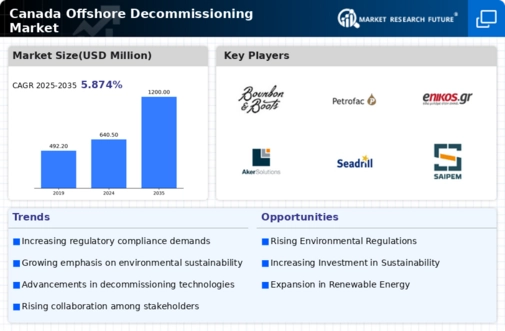Economic Factors and Market Dynamics
Economic factors significantly influence the offshore decommissioning market in Canada. Fluctuations in oil prices and the overall economic climate can impact investment decisions related to decommissioning projects. When oil prices are high, companies may prioritize decommissioning to reallocate resources towards more profitable ventures. Conversely, during periods of low oil prices, decommissioning activities may be delayed, affecting market growth. The Canadian offshore decommissioning market is projected to grow at a rate of 12% annually, driven by the need for responsible asset management and the economic imperative to retire aging infrastructure. This dynamic interplay between economic conditions and decommissioning activities underscores the importance of strategic planning within the offshore decommissioning market.
Aging Infrastructure and Asset Retirement
The aging infrastructure of offshore oil and gas facilities in Canada is a critical driver for the offshore decommissioning market. Many platforms and installations are reaching the end of their operational life, necessitating decommissioning to ensure safety and environmental protection. The National Energy Board has reported that approximately 30% of offshore platforms are over 30 years old, indicating a pressing need for decommissioning activities. This trend is expected to accelerate as more assets become obsolete, leading to an estimated market growth of 20% in decommissioning services over the next decade. Companies are increasingly recognizing the importance of timely asset retirement, which not only mitigates risks but also aligns with the evolving regulatory framework governing the offshore decommissioning market.
Public Awareness and Stakeholder Engagement
Public awareness and stakeholder engagement are increasingly shaping the offshore decommissioning market in Canada. As communities become more informed about environmental issues, there is growing pressure on companies to conduct decommissioning in a responsible manner. Stakeholders, including local communities and environmental organizations, are advocating for transparency and accountability in decommissioning processes. This heightened awareness can lead to increased scrutiny of decommissioning projects, compelling companies to adopt best practices and engage with stakeholders proactively. The offshore decommissioning market is likely to see a shift towards more community-inclusive approaches, which may enhance project approval rates and foster trust. This trend could potentially drive market growth by 10% as companies align their operations with public expectations.
Regulatory Compliance and Environmental Standards
The offshore decommissioning market in Canada is significantly influenced by stringent regulatory compliance and environmental standards. The Canadian government has established comprehensive regulations to ensure that decommissioning activities minimize environmental impact. This includes adherence to the Canadian Environmental Assessment Act, which mandates thorough assessments before any decommissioning project. As a result, companies operating in this market must invest in compliance measures, which can increase operational costs but also enhance their reputation. The market is projected to grow as companies prioritize compliance, with estimates suggesting a potential increase in decommissioning projects by 15% over the next five years. This regulatory landscape not only drives demand for decommissioning services but also encourages innovation in environmentally friendly practices within the offshore decommissioning market.
Technological Advancements in Decommissioning Techniques
Technological advancements play a pivotal role in shaping the offshore decommissioning market in Canada. Innovations in decommissioning techniques, such as remote-operated vehicles (ROVs) and advanced cutting technologies, enhance efficiency and safety during decommissioning operations. These technologies reduce the time and costs associated with decommissioning projects, making them more attractive to operators. For instance, the use of ROVs can decrease operational downtime by up to 25%, thereby increasing the overall productivity of decommissioning activities. As companies adopt these advanced technologies, the offshore decommissioning market is likely to experience a surge in demand, with projections indicating a potential market expansion of 18% in the coming years. This technological evolution not only streamlines processes but also contributes to the sustainability goals of the industry.
























Leave a Comment